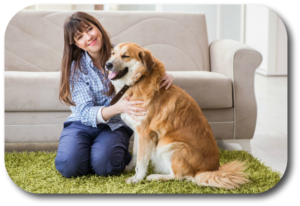We were in Snellville last week working with a new Home Dog Training client and his Golden Retriever named Jupiter. Jupiter was just over a year old and full of “Golden Retriever energy”. She loved to steal things, jump on family members and house guests, run outside and never come when called, and just be a cute, but wild child. We spent about four hours training our clients how to be Jupiter’s leader and allowing Jupiter to discover that she was no longer allowed to be the queen of the house.
Having three kids under the age of twelve, out clients quickly understood what they needed to do and Jupiter accepted that her being the queen had come to an end. Everyone was happy. As we were winding up, our client asked about “play time”. They understood that they couldn’t let Jupiter get away with stuff and they need to be the leaders. How does play time work into the process?

We started our answer by asking our clients if they remembered back in Grade School when they had morning and afternoon recess? It allowed them to get out, take a break, and let off a little pent up energy. It also allowed them to focus on building relationships instead of spelling words. It was a critical part their our educational process…
You might not believe it, but playing is a critical part of your dog’s training too!
When you are playing with your dog, it all comes down to the rules you set and behavior your expect. The first thing that you should remember is that “inside” is very different than “outside”. The rules and activities you play in both locations are different.
When you want to play inside, you need to understand that this location will also be the place where you will want your dog calm when it is not “play time”. In order to accomplish this, you should try and keep your “inside play activities” as calm and focused as possible. Some inside play tips and activities are:
- Always remain calm when playing with your dog inside. Do not play in areas such as entrance ways, the kitchen, or hallways. Play in larger, more open areas such as your family room or a large, enclosed back porch or sun room.
- Be able to quickly stand while you are playing. Standing is a natural show of dominance and communicates “I am done playing”. If things start to become out of control, you need a quick “off switch” and standing often accomplishes that.
- Play calm games such as “roll the ball” or “hide and go seek” with a toy or goodie.
- Include obedience exercises such as sit, stay, and come in your “play time”. This will help your dog understand that it is important to calmly focus on you and obey your directions.
- Besides obedience exercises, you can include “tricks” in your inside play time. “Roll over”, “play dead”, and “Shake my hand” are always fun things to do with your dog.
- The bottom line is that playing inside should be fun, but always controlled.
Now, we can look at what playing may be like outside. You can think of it like this; you were never allowed to play football in the living room. The same general concept is true when playing with your dog outside. It is OK to play football outside…
Here are some tips:
- Always play in an enclosed area. You don’t want your adrenalized dog to see something up the street or in the neighbor’s back yard and just run off.
- Never engage in rough or overly exuberant play with a large or powerful dog. They will not understand that it is not OK to exhibit the same behavior. I don’t think that you want your American Bulldog jumping on everyone coming into the house.
- Don’t play “Chase me! Chase me! / Tag You Are It!”. This tells your dog that it is OK to always chase you and/or your guests and to “tag them”. We tag someone by touching them on the shoulder. Dogs tag other dogs by jumping on them and nipping their fur. I am sure that you don’t want this for your guests.
- If you have a “hyper dog”, don’t play “Where is the birdie! Where is the birdie! Go get the Birdie!” with him. This encourages your dog being hyperactive both outside and inside.
- Never play tug of war with your dog. This encourages him not to give you things back when you ask.
- Play games like fetch or throw some goodies on the ground for him to forage. Give him Kong toys or other toys that stimulate his mind. You can also play scent games where you put a goodie under one of three buckets and encourage your dog find the goodie.
Whether you are playing inside or outside, try to include at least 30 to 60 minutes of play with your dog each day. As I mentioned earlier, play time is part of your dog’s education. It builds a bond of trust and security between your dog and you. It also allows you to see how your dog reacts to specific stimuli and situations. Do not only play inside with your dog. Just like recess, your dog needs time “just to go crazy”. You don’t want to do this inside.
It all comes down to common sense. Do not encourage games that reward behaviors you do not want in your dog. Encourage games that reward your dog for maintaining your rules.
Please call Robin or me at (770) 718-7704 if you need any dog training help. We are blessed to have been your local dog training professionals for over fifteen years. We have trained over 5,000 great dogs and loving families and are ready to help you.

Follow Us!